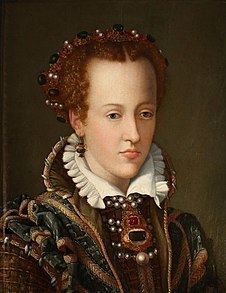Burial Medici Chapel | Name Joanna Austria, | |
 | ||
Tenure 21 April 1574 – 11 April 1578 Born 24 January 1547Prague, Bohemia ( 1547-01-24 ) Issueamong others... Eleanor, Duchess of Mantua and MontferratAnna de' MediciMaria, Queen of FrancePhilip, Grand Prince of Tuscany Mother Anna of Bohemia and Hungary Spouse Francesco I de' Medici, Grand Duke of Tuscany (m. 1565) Children Marie de' Medici, Eleanor de' Medici, Philip de' Medici, Anna de' Medici Parents Anne of Bohemia and Hungary, Ferdinand I, Holy Roman Emperor Siblings Archduchess Eleanor of Austria Similar People Francesco I de' Medici - Grand Du, Marie de' Medici, Bianca Cappello, Ferdinand I - Holy Roman E, Anne of Bohemia and Hung | ||
Joanna of Austria (German Johanna von Österreich, Italian Giovanna d'Austria) (24 January 1547 – 11 April 1578) was born an Archduchess of Austria as the youngest daughter of Ferdinand I, Holy Roman Emperor, and Anna of Bohemia and Hungary. By marriage, she was the Grand Princess of Tuscany and later the Grand Duchess of Tuscany. One of her daughters was Marie de Medici, second wife of King Henry IV of France.
Contents
Family
Joanna was born in Prague as the youngest of 15 children. She never knew her mother and eldest sister as her mother died 2 days after Joanna's birth and her sister Elisabeth of Austria, Queen of Poland, died two years before Joanna was born.
Her paternal grandparents were Philip I of Castile and Joanna of Castile. Her maternal grandparents were King Vladislaus II of Bohemia and Hungary, and Anna of Foix-Candale. Through her father, Joanna was also a descendant of Isabella I of Castile and Mary of Burgundy.
Marriage
Her marriage to Francesco I de' Medici, Grand Duke of Tuscany, took place on 18 December 1565 in Florence, after she solemnly arrived in the city by the Porta al Prato. Giorgio Vasari and Vincenzo Borghini, with the help of Giovanni Caccini made big festivities for these event. The party was also taken to the Medici Villa in Poggio a Caiano.
Nevertheless, Joanna was homesick and unhappy. Ignored by her husband, and despised by the Florentines for her Austrian hauteur, she never felt at home in Florence.
Her father-in-law, Cosimo I de' Medici, was reasonably kind to Joanna. He had the courtyard of the Palazzo Vecchio specially decorated for her; the lunettes were painted with murals of Austrian towns by pupils of Vasari, and Verrocchio's Putto with Dolphin fountain was brought down from the Careggi villa where it had been set up in the garden by Lorenzo de' Medici.
The position of Joanna in the Florentine court was difficult during most of her marriage: between 1566 and 1575, she gave birth to six daughters, of whom only three survived infancy. The absence of a male heir to continue the dynasty was the cause of constant conflict with her husband, who preferred the company and love of his mistress Bianca Cappello, who gave birth to a son, Antonio, in 1576.
Finally, in 1577 Joanna gave birth to the long-awaited heir, baptised Filippo in honour of King Philip II of Spain, Joanna's first cousin. The birth was celebrated with great joy by all the court, because thus was secured the succession of the Grand Duchy for another generation and eliminated all the hopes of Bianca Cappello to have her "son" Antonio as heir of Tuscany. In the end, however, it was all for naught: Joanna's brother-in-law, Ferdinando, succeeded Francesco as Grand Duke.
Death
On 10 April 1578, Joanna – heavily pregnant with her eighth child – fell from the stairs in the Grand Ducal Palace in Florence. Some hours later, she gave birth to a son, who, born prematurely, died immediately. She died the next day on 11 April. Francesco subsequently married his mistress, Bianca Cappello and then made her grand duchess.
The mysterious circumstances around this accident caused rumours accusing her husband and his mistress of murdering Joanna, so that they could be married. However, modern medical investigation of her remains confirm the official reports of her death as caused by the birth (the child presented arm first, and Joanna suffered a ruptured uterus). Joanna suffered from scoliosis: her spine and pelvis were severely deformed. It is clear from the condition of her pelvis that her previous births had been difficult, and it seems remarkable that she had survived them.
Issue
The eight children of Francesco and Joanna were:
- Eleonora de' Medici (28 February 1567 – 9 September 1611) married Vincenzo I Gonzaga, Duke of Mantua and had issue.
- Romola de' Medici (20 November 1568 – 2 December 1568) died in infancy.
- Anna de' Medici (31 December 1569 – 19 February 1584) died unmarried.
- Isabella de' Medici (30 September 1571 – 8 August 1572) died in infancy.
- Lucrezia de' Medici (7 November 1572 – 14 August 1574) died in infancy.
- Maria de' Medici (26 April 1575 – 3 July 1642) married Henri IV of France and had issue.
- Filippo de' Medici (20 May 1577 – 29 March 1582) died in infancy.
- Stillborn son (10 April 1578 – 10 April 1578).
Out of a total of eight children, only two daughters, Eleanor and Marie lived to adulthood, the rest of the children died young.
